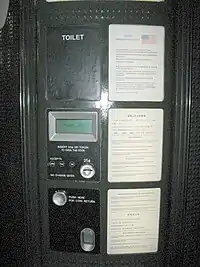Committee to End Pay Toilets in America
The Committee to End Pay Toilets in America, or CEPTIA, was a 1970s grass-roots political organization which was one of the main forces behind the elimination of pay toilets in many American cities and states.
 | |
| Founded | 1970 |
|---|---|

History
Ira Gessel, [1]
Founded in 1970 by then-nineteen-year-old Ira Gessel, the Committee's purpose was to "eliminate pay toilets in the U.S. through legislation and public pressure."[1][2][3]
Starting a national crusade to cast away coin-operated commodes, Gessel told newsmen, "You can have a fifty-dollar bill, but if you don't have a dime, that metal box is between you and relief."[4] Membership in the organization cost only $0.25, and members received the Committee's newsletter, the Free Toilet Paper. Headquartered in Dayton, Ohio, USA, the group had as many as 1,500 members, in seven chapters.[1]
The group also sponsored the Thomas Crapper Memorial Award, which was given to "the person who has made an outstanding contribution to the cause of CEPTIA and free toilets."[1]
In 1973, Chicago became the first American city to act when the city council voted 37–8 in support of a ban on pay toilets in that city. According to at least one source, this was "... a direct response, evidently," to CEPTIA.[4][5][6]
Achievements
According to The Wall Street Journal, there were, in 1974, at least 50,000 pay toilets in America, mostly made by the Nik-O-Lok Company. Despite this flourishing commerce, CEPTIA was successful over the next few years in obtaining bans in New York, New Jersey, Minnesota, California, Florida, and Ohio.[7] Lobbying was so successful that by June 1976, twelve states had enacted bans and the group announced that it was disbanding, declaring its mission mostly achieved.[8]
References
- Wallechinsky, David; Wallace, Irving. The People's Almanac. Doubleday and Company, Inc. p. 1256. ISBN 0-385-04186-1.
- Franckling, Kenneth (August 21, 1974). "Ban on pay toilets disputed". The Dispatch.
- Geringer, Dan (May 2, 1972). "A New Kind of Protest". The Palm Beach Post. pp. B1, B3.
- Felton, Bruce; Fowler, Mark (1994). The Best, Worst, & Most Unusual. Sterling Publishing Company, Inc. p. 262. ISBN 978-0-88365-861-1.
- Wiggins, Ron (August 2, 1973). "Comfort-For-Pay Being Flushed Out". Evening Independent.
- "Group Seeks To End Pay Toilets: And It Has Had Some Success Already". Sarasota Journal. July 25, 1973.
- "Clinched fist rising from commodes ends". Hamilton. August 19, 1976: B–6. Cite journal requires
|journal=(help) - Dunphy, Robert J. (June 20, 1976). "Notes: Pay Toilets". The New York Times.